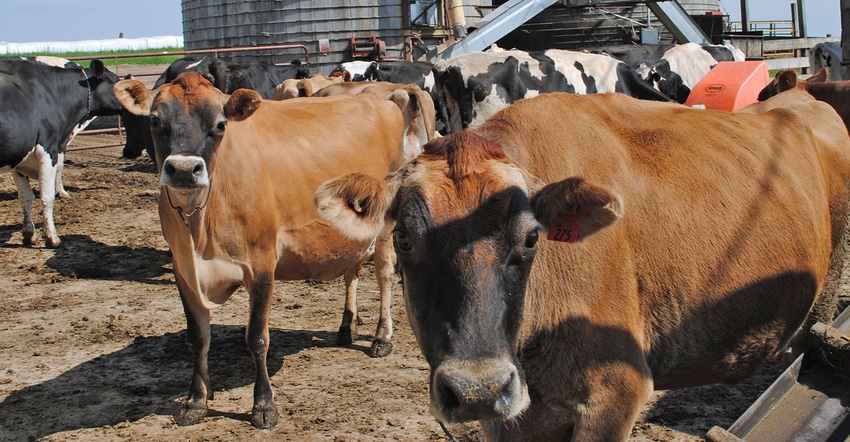
U.S. milk production is decreasing, according to Bob Cropp, University of Wisconsin-Madison dairy economist.
“Increases in milk production are well below 1% from the last quarter of 2018 and going into this year, with February milk production just 0.1% higher than a year ago,” Cropp says. “March production was 0.6% lower than a year ago, and April’s production was up just 0.1%. This has reduced dairy product production and increased dairy product prices.”
Dairy product stocks decline
The latest dairy product production numbers, for March, compared to the year before showed production down 3.9% for butter, 3.2% for cheddar cheese, 0.7% for total cheese, 8% for nonfat dry milk and 14.2% for dry whey. Lower production has tightened stock levels, Cropp says. The March 31 stocks compared to a year ago showed butter 1.4% lower, while cheese stocks were still higher. They have tightened, with American cheese stocks just 2.3% higher and total cheese stocks 4.3% higher. Nonfat dry milk stocks were 2.9% lower, but dry whey stocks were 5.5% higher.
“Since the end of April, butter is now at $2.34 per pound and is up 2 cents,” Cropp says. “Cheddar barrels, now at $1.62 per pound, are unchanged but were as high as $1.74 earlier in May; and 40-pound cheddar blocks, now at $1.62, are also unchanged but were as high as $1.70 earlier in the month. Nonfat dry milk, now at $1.04 per pound, is 2 cents higher than the end of April, but dry whey, now at 35 cents per pound, is just 1 cent higher.”
The higher average dairy product prices are pushing milk prices higher. The Class III price, which was below $14 for both January and February, was $15.96 in April and will be near $16.35 for May.
Dairy exports impact dairy product prices. March exports compared to a year ago showed nonfat dry milk-skim milk powder exports 10% lower, with exports down 21% to Mexico and 86% to China, according to USDA. Butter exports were 33% lower, and total whey product exports were 22% lower due to whey exports being down 52% to China. This is a result of China’s retaliatory tariffs, but also African swine fever, which has taken a toll on the country’s swine herd.
Cheese exports, however, have been increasing. February cheese exports were 16% higher than a year ago, the second-highest volume ever, and March exports were 10% higher for a record volume. While cheese exports to Mexico were down 17% as retaliatory tariffs on U.S. cheese remain in place, cheese exports to South Korea were 39% higher, with record exports to Southeast Asia up 33%, to Japan up 28%, and to Central America up 33%. South Korea surpassed Mexico as the largest cheese market.
Milk production slows
Key factors indicate that milk prices will continue to strengthen as the year progresses, Cropp says.
“Milk production is forecasted to increase no more than 0.5% for the year,” he says. “April’s milk production up just 0.1% from a year ago was the net result of 1% fewer milk cows than a year ago and 1.1% more milk per cow. It appears the spring flush in milk production will be weaker than normal.”
The late wet and rather cool spring has delayed corn and soybean planting. Portions of some wet fields in the Corn Belt may not get planted. There are reports of winterkill of alfalfa in Wisconsin.
“And the weather forecast for above-normal wet weather going into June could make harvesting of first-crop alfalfa difficult and lower its quality. All of this can make higher feed prices and lower-quality forage going into fall and winter, lowering increases in milk per cow,” Cropp explains.
Fluid (beverage) milk sales continue downward, making more milk available for manufactured products such as cheese. Compared to a year ago, first-quarter conventional fluid milk sales were 2.2% lower, and fluid organic milk sales were 4.5% lower, resulting in total fluid milk sales 2.4% lower, according to USDA. “But with continued growth in the economy, low unemployment and high wages, modest growth in butter and cheese sales is anticipated to increase total domestic sales of milk,” Cropp predicts.
Where dairy exports are headed will have a major bearing on how much milk prices improve.
Impact of tariffs
“President [Donald] Trump just announced that tariffs on Canada and Mexico aluminum and steel have been lifted,” Cropp says. “In response, Canada and Mexico will lift retaliatory tariffs on U.S. dairy products. The lifting of Mexico’s retaliatory tariffs on U.S. cheese could resume higher cheese exports to Mexico by last quarter of this year.
“Increased tariffs imposed by the U.S. on China’s goods and China retaliating with higher tariffs on U.S. dairy products could further reduce dairy exports to China. Unless the U.S.-China trade dispute is ended, exports to China will not improve in 2019. We can expect continued relatively strong exports to South Korea, Southeast Asia and maybe to Japan and Central America. So, while trade volume may end up lower than last year, exports should still be at a level to add support to milk prices.”
Cropp says it now looks like there is a good possibility that milk prices could strengthen the last quarter of the year.
“A Class III price near $17 by June and in the high $17s by September or October seems possible,” he says.
O’Leary is the editor of Wisconsin Agriculturist, a sister publication.
About the Author(s)
You May Also Like






